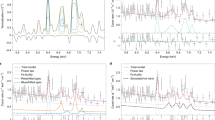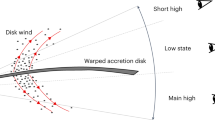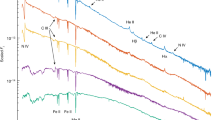Abstract
All disc-accreting astrophysical objects produce powerful disc winds. In compact binaries containing neutron stars or black holes, accretion often takes place during violent outbursts. The main disc wind signatures during these eruptions are blue-shifted X-ray absorption lines, which are preferentially seen in disc-dominated ‘soft states’1,2. By contrast, optical wind-formed lines have recently been detected in ‘hard states’, when a hot corona dominates the luminosity3. The relationship between these signatures is unknown, and no erupting system has as yet revealed wind-formed lines between the X-ray and optical bands, despite the many strong resonance transitions in this ultraviolet (UV) region4. Here we report that the transient neutron star binary Swift J1858.6-0814 exhibits wind-formed, blue-shifted absorption lines associated with C iv, N v and He ii in time-resolved UV spectroscopy during a luminous hard state, which we interpret as a warm, moderately ionized outflow component in this state. Simultaneously observed optical lines also display transient blue-shifted absorption. Decomposing the UV data into constant and variable components, the blue-shifted absorption is associated with the former. This implies that the outflow is not associated with the luminous flares in the data. The joint presence of UV and optical wind features reveals a multi-phase and/or spatially stratified evaporative outflow from the outer disc5. This type of persistent mass loss across all accretion states has been predicted by radiation–hydrodynamic simulations6 and helps to explain the shorter-than-expected duration of outbursts7.
This is a preview of subscription content, access via your institution
Access options
Access Nature and 54 other Nature Portfolio journals
Get Nature+, our best-value online-access subscription
$29.99 / 30 days
cancel any time
Subscribe to this journal
Receive 51 print issues and online access
$199.00 per year
only $3.90 per issue
Buy this article
- Purchase on Springer Link
- Instant access to full article PDF
Prices may be subject to local taxes which are calculated during checkout




Similar content being viewed by others
Data availability
The data underlying this article are publicly available at https://archive.stsci.edu/hst/search.php program ID 15984 for HST/FUV data, http://archive.eso.org/cms.html program 190ID 2103.D-5052(A) for VLT/X-Shooter and https://gtc.sdc.cab.inta-csic.es/gtc/ program ID GTC23-19A for GTC/OSIRIS. X-ray data from NICER used all the OBSIDs starting with 120040, 220040, 320040 and 359201 accessible from HIESARC (https://heasarc.gsfc.nasa.gov/docs/nicer/nicer_archive.html). Source data are provided with this paper.
Code availability
Codes used for the analysis are available from the corresponding author upon reasonable request.
References
Ponti, G. et al. Ubiquitous equatorial accretion disc winds in black hole soft states. MNRAS 422, L11–L15 (2012).
Homan, J. et al. Evidence for simultaneous jets and disk winds in luminous low-mass x-ray binaries. Astrophys. J. 830, L5 (2016).
Muñoz-Darias, T. et al. The changing-look optical wind of the flaring x-ray transient Swift J1858.6-0814. Astrophys. J. 893, L19 (2020).
Long, K. S. & Knigge, C. Modeling the spectral signatures of accretion disk winds: a new Monte Carlo approach. Astrophys. J. 579, 725–740 (2002).
Waters, T., Proga, D. & Dannen, R. Multiphase AGN winds from x-ray-irradiated disk atmospheres. Astrophys. J. 914, 62 (2021).
Higginbottom, N. et al. Thermal and radiation driving can produce observable disc winds in hard-state X-ray binaries. MNRAS 492, 5271–5279 (2020).
Tetarenko, B. E., Lasota, J. P., Heinke, C. O., Dubus, G. & Sivakoff, G. R. Strong disk winds traced throughout outbursts in black-hole X-ray binaries. Nature 554, 69–72 (2018).
Gehrels, N. et al. The Swift gamma-ray burst mission. Astrophys. J. 611, 1005–1020 (2004).
Krimm, H. A. et al. Swift reports the detection of a new galactic transient source Swift J1858.6-0814. The Astronomer’s Telegram 12151, 1 (2018).
Bright, J. et al. AMI-LA radio observations of the galactic X-ray transient Swift J1858.6-0814. The Astronomer’s Telegram 12184, 1 (2018).
Vasilopoulos, G., Bailyn, C. & Milburn, J. Swift J1858.6-0814: Localization and variability of the optical counterpart. The Astronomer’s Telegram 12164, 1 (2018).
Kennea, J. A. & Krimm, H. A. Swift J1858.6-0814: Swift XRT and UVOT localization. The Astronomer’s Telegram 12160, 1 (2018).
Buisson, D. J. K. et al. Discovery of thermonuclear (Type I) X-ray bursts in the X-ray binary Swift J1858.6-0814 observed with NICER and NuSTAR. MNRAS 499, 793–803 (2020).
Buisson, D. J. K. et al. Dips and eclipses in the X-ray binary Swift J1858.6-0814 observed with NICER. MNRAS 503, 5600–5610 (2021).
Ludlam, R. M. et al. Initial NICER observation of the new X-ray transient Swift J1858.6-0814. The Astronomer’s Telegram 12158, 1 (2018).
Motta, S. E. et al. Swift observations of V404 Cyg during the 2015 outburst: X-ray outflows from super-Eddington accretion. MNRAS 471, 1797–1818 (2017).
Hare, J. et al. NuSTAR observations of the transient galactic black hole binary candidate Swift J1858.6–0814: a new sibling of V404 Cyg and V4641 Sgr? Astrophys. J. 890, 57 (2020).
van den Eijnden, J. et al. The variable radio counterpart of Swift J1858.6-0814. MNRAS 496, 4127–4140 (2020).
Begelman, M. C., McKee, C. F. & Shields, G. A. Compton heated winds and coronae above accretion disks. I. Dynamics. Astrophys. J. 271, 70–88 (1983).
Done, C., Gierliński, M. & Kubota, A. Modelling the behaviour of accretion flows in X-ray binaries. Everything you always wanted to know about accretion but were afraid to ask. Astron. Astrophys. Rev. 15, 1–66 (2007).
Higginbottom, N. & Proga, D. Coronae and winds from irradiated disks in x-ray binaries. Astrophys. J. 807, 107 (2015).
Buisson, D. J. K. et al. Soft X-ray emission lines in the X-ray binary Swift J1858.6-0814 observed with XMM-Newton Reflection Grating Spectrometer: disc atmosphere or wind? MNRAS 498, 68–76 (2020).
Muñoz-Darias, T. et al. Regulation of black-hole accretion by a disk wind during a violent outburst of V404 Cygni. Nature 534, 75–78 (2016).
Shields, G. A., McKee, C. F., Lin, D. N. C. & Begelman, M. C. Compton-heated winds and coronae above accretion disks. III. Instability and oscillations. Astrophys. J. 306, 90–106 (1986).
Ganguly, S. & Proga, D. On the wind-driven relaxation cycle in accretion disks. Astrophys. J. 890, 54 (2020).
Ioannou, Z. et al. Understanding the LMXB X2127+119 in M 15. II. The UV data. Astron. Astrophys. 399, 211–218 (2003).
Neilsen, J. et al. A NICER view of a highly absorbed flare in GRS 1915+105. Astrophys. J. 902, 152 (2020).
Dubus, G., Done, C., Tetarenko, B. E. & Hameury, J.-M. The impact of thermal winds on the outburst lightcurves of black hole X-ray binaries. Astron. Astrophys. 632, A40 (2019).
Luketic, S., Proga, D., Kallman, T. R., Raymond, J. C. & Miller, J. M. On the properties of thermal disk winds in x-ray transient sources: a case study of GRO J1655-40. Astrophys. J. 719, 515–522 (2010).
Done, C., Tomaru, R. & Takahashi, T. Thermal winds in stellar mass black hole and neutron star binary systems. MNRAS 473, 838–848 (2018).
Charles, P. et al. Hot, dense He II outflows during the 2017 outburst of the X-ray transient Swift J1357.2-0933. MNRAS 489, L47–L52 (2019).
Green, J. C. et al. The Cosmic Origins Spectrograph. Astrophys. J. 744, 60 (2012).
Eracleous, M. & Horne, K. The speedy magnetic propeller in the cataclysmic variable AE Aquarii. Astrophys. J. 471, 427–446 (1996).
Vernet, J. et al. X-shooter, the new wide band intermediate resolution spectrograph at the ESO Very Large Telescope. Astron. Astrophys. 536, A105 (2011).
Cepa, J. et al. In Optical and IR Telescope Instrumentation and Detectors Vol. 4008 of Society of Photo-Optical Instrumentation Engineers (SPIE) Conference Series (eds Iye, M. & Moorwood, A. F.) 623–631 (SPIE, 2000); https://doi.org/10.1117/12.395520
Freudling, W. et al. Automated data reduction workflows for astronomy. The ESO Reflex environment. Astron. Astrophys. 559, A96 (2013).
Drew, J. E. Inclination and orbital-phase-dependent resonance line-profile calculations applied to cataclysmic variable winds. MNRAS 224, 595–632 (1987).
Done, C. In Accretion Processes in Astrophysics (eds González Martínez-País, I., Shahbaz, T. & Casares Velázquez, J.) 184–227 (Cambridge Univ. Press, 2014).
Woods, D. T., Klein, R. I., Castor, J. I., McKee, C. F. & Bell, J. B. X-ray–heated coronae and winds from accretion disks: time-dependent two-dimensional hydrodynamics with adaptive mesh refinement. Astrophys. J. 461, 767–804 (1996).
Proga, D. & Kallman, T. R. On the role of the ultraviolet and x-ray radiation in driving a disk wind in x-ray binaries. Astrophys. J. 565, 455–470 (2002).
Frank, J., King, A. & Raine, D. J. Accretion Power in Astrophysics 3rd edn (Cambridge Univ. Press, 2002).
Ashman, K. M., Bird, C. M. & Zepf, S. E. Detecting bimodality in astrometrical datasets. Astron. J. 108, 2348–2361 (1994).
Acknowledgements
N.C.S. and C.K. acknowledge support from the Science and Technology Facilities Council (STFC), and from STFC grant ST/M001326/1. Partial support for K.S.L.’s effort on the project was provided by NASA through grant numbers HST-GO-15984 and HST-GO-16066 from the Space Telescope Science Institute, which is operated by AURA, Inc., under NASA contract NAS 5-26555. N.C.S. thanks T. Royle for helping to coordinate the time-critical observations in this article. N.D.D. acknowledges support from a Vidi grant for the Netherlands Organization for Scientific Research (NWO). J.V.H.S. acknowledges support from STFC grant ST/R000824/1. M.A.P., J.C., F.J.-I. and T.M.D. acknowledge support from grants AYA2017-83216-P and PID2020-120323GB-I00. T.M.-D. also acknowledges RYC-2015-18148 and EUR2021-122010. T.M.-D. and M.A.P. acknowledge support from grants with references ProID2020010104 and ProID2021010132. J.M. acknowledges a Herchel Smith Fellowship at Cambridge. T.D.R. acknowledges a financial contribution from the agreement ASI-INAF n.2017-14-H.0. J.v.d.E. is supported by a Lee Hysan Junior Research Fellowship from St Hilda’s College, Oxford. G.V. acknowledges support by NASA grants 80NSSC20K1107, 80NSSC20K0803 and 80NSSC21K0213. M.Ö.A. acknowledges support from the Royal Society through the Newton International Fellowship program. J.A.C. acknowledges support from grants PICT-2017-2865 (ANPCyT), PID2019-105510GB-C32/AEI/10.13039/501100011033 and FQM-322, as well as FEDER funds.
Author information
Authors and Affiliations
Contributions
N.C.S. and C.K. wrote the original proposal, performed the data analysis and wrote the paper with significant feedback from K.S.L., D.A., F.M.V., S.d.P., J.M. and M. Middleton M.A.P., J.C., F.J.-I. and T.M.-D. provided the GTC data. J.V.H.S. reduced the X-Shooter data and assisted in designing the observations. D.J.K.B. and D.A. provided the X-ray data. D.A.H.B., J.A.C., V.A.C., N.D.D., S.d.P., M.D.T., R.F., C.G., J.V.H.S., M.P., M.Ö.A., L.R., T.D.R., J.v.d.E., F.M.V., M. Méndez, C.B., P.C., P.G., M.G., S.S., G.V. and P.W. assisted in proposing and planning the multiwavelength observations. All authors contributed to the original proposal, discussed the results and commented on the manuscript.
Corresponding author
Ethics declarations
Competing interests
The authors declare no competing interests.
Peer review
Peer review information
Nature thanks Daniel Proga and the other, anonymous, reviewer(s) for their contribution to the peer review of this work. Peer reviewer reports are available.
Additional information
Publisher’s note Springer Nature remains neutral with regard to jurisdictional claims in published maps and institutional affiliations.
Extended data figures and tables
Extended Data Fig. 1 The logarithmic far-UV flux distribution of J1858 during our observations.
The distribution is clearly bimodal, consistent with the visual impression from the light curve (Fig. 1b) of the variability being due to a flaring component that is superposed on a roughly constant component. The grey line is the optimal decomposition of the distribution into two Gaussians, as suggested by the KMM algorithm42. The blue and red lines correspond to the individual Gaussians. KMM rejects the null hypothesis of a single component with extremely high significance (p < 10−43).
Extended Data Fig. 2 The far-UV continuum and driving light curves.
The black histogram shows the light curve of Swift J1858.6−0814 constructed from three broad wavelength regions that exclude the three strongest emission lines (N v λ1240, Si iv λ1400 and He ii λ1640). The specific regions used were λλ1290 Å – 1390 Å, 1410 Å – 1630 Å, 1660 Å – 1850 Å. The light curve is shown normalized to an estimate of the underlying constant level (80 c s−1). The driving light curve used in the decomposition, D(t), was constructed from this and is shown as the red curve. It was obtained by subtracting the estimate of the constant level, setting any slightly negative values to zero, and using a 5-point, 2nd order Savitzky-Golay filter to produce a slightly smoother, higher S/N version of the light curve.
Supplementary information
Rights and permissions
About this article
Cite this article
Castro Segura, N., Knigge, C., Long, K.S. et al. A persistent ultraviolet outflow from an accreting neutron star binary transient. Nature 603, 52–57 (2022). https://doi.org/10.1038/s41586-021-04324-2
Received:
Accepted:
Published:
Issue Date:
DOI: https://doi.org/10.1038/s41586-021-04324-2
This article is cited by
-
Black holes and neutron stars beat alike when bright
Nature (2023)
-
A shared accretion instability for black holes and neutron stars
Nature (2023)
-
Frontiers in accretion physics at high X-ray spectral resolution
Nature Astronomy (2022)
Comments
By submitting a comment you agree to abide by our Terms and Community Guidelines. If you find something abusive or that does not comply with our terms or guidelines please flag it as inappropriate.



